Statements
Undine Spragg "liked to know that what belonged to her was coveted by others. Altogether, "she relished the image of her own charm mirrored in people around her."
--Edith Wharton
Custom of the Country
The CAKES serve frothed up castles of delusion, hyperbolic princess-lands that ooze the saccharine, nuclear-pink glow of the girl toy aisles in FAO Schwarz. Rita Hayworth in the film "Gilda", --hypnotic sizzle. Glamour Trance freezes time, stunts emotional development, yet supremely entertains. In Nabokovian poshlust-glitz, the CAKES embody both entrancing appearances, and the intoxication they kindle.
In Society of the Spectacle Guy DeBord delineates a "social space blanketed by stratum after stratum of commodities" where "consumerism is tautological". Acting out circular reasoning, one moves round and round the large CAKES drawn into mirrors and enticing layers of stuff. Likewise, shoppers are lured into a buying loop by "the cunning of the self-perpetuating commodity," its siren call of more, its cellophane promise to raise one in the similarly glazed esteem of one's social circle.
The CAKES muse on paradoxes in our value systems. On one hand, we, drugged on stockpiling, have lost some essential function of the heart. Wrapped up in buying-lust, we miss the turpitude growing insidiously all around us. Blind eyes are turned to the military industrial complex and other corporate scourges: drone slaughter, abhorrent torture of gentle farm animals, windowless, solitary-confinement prison blocks.
That said, psychological and cultural insight can lurk in the shadows of display racks. Through fashion, one establishes persona, identity in the social sphere. Overstated adornment is paramount in significant rituals of primitive people. Invoking Nietzsche's autocratic child's games and self-rolling wheel, the CAKES are restorative diversion.
Likewise, asserting the interdependence of the 'substantial' and the 'superficial' in her craft, Helene Cisoux acknowledges "writing's necessary relation with narcissism." In fact, her ecriture feminine espouses "contradiction, incongruity, and polyvalent meaning". Submerged in the depths behind the surface of the glossy CAKES is a "level of subconscious", "an inner text in the text".
A heretic, I revere the Golden Calf. I insert an escape clause into banal contemporary art's Oligarchical governance. (Descartes, Duchamp, Warhol.) I profane their cold, anti-retinal sacred cow. As Carter Ratcliff put it, "beauty" is "the spook in the theoretical machine". If a big fluffy white dog saunters into a meeting of pedigreed curators, it will steal the attention of all—concepts temporarily thrown to the wind.
In the film "Big Animal", a fabulous show camel turns up to share dinner through the window of a dour Eastern European couple's abode. The camel brightens their lives and cheers all who encounter it. Then the pragmatists come upon the dear being and start to ring up the cash register, calculating what pelts and meat would bring on the open market. Meanwhile other "good citizens" see a non-contributor in the camel: "He should be working, paying taxes", etc. In the end with new fur cap on a boy, we surmise what happened. All the same, the couple's emotional demeanor has been transformed permanently through communion with the fanciful, mystical creature. Compassionate action notwithstanding, the quixotic CAKES likewise nod to Lao Tzu's "greatest treasure, contentment."
© 2011-14 Gae Savannah

Cakes
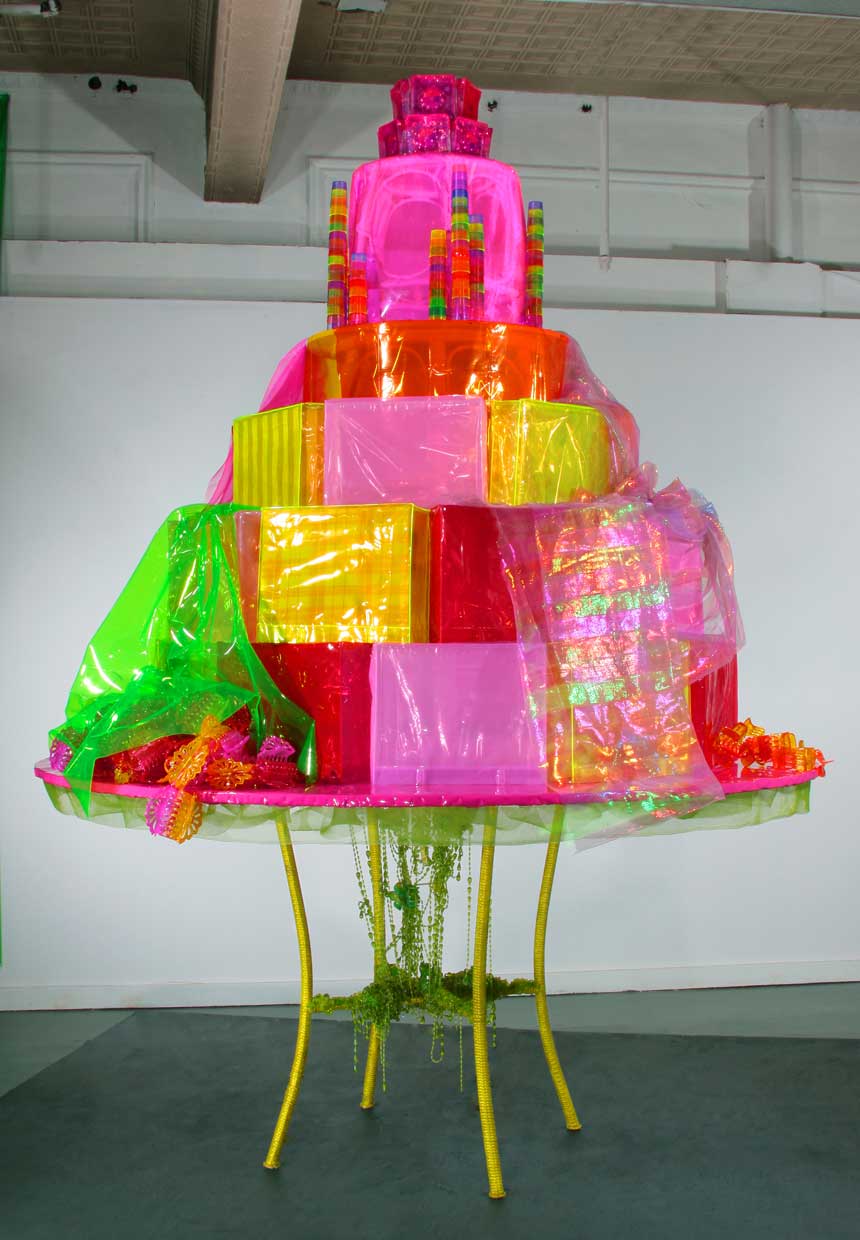
Veritas
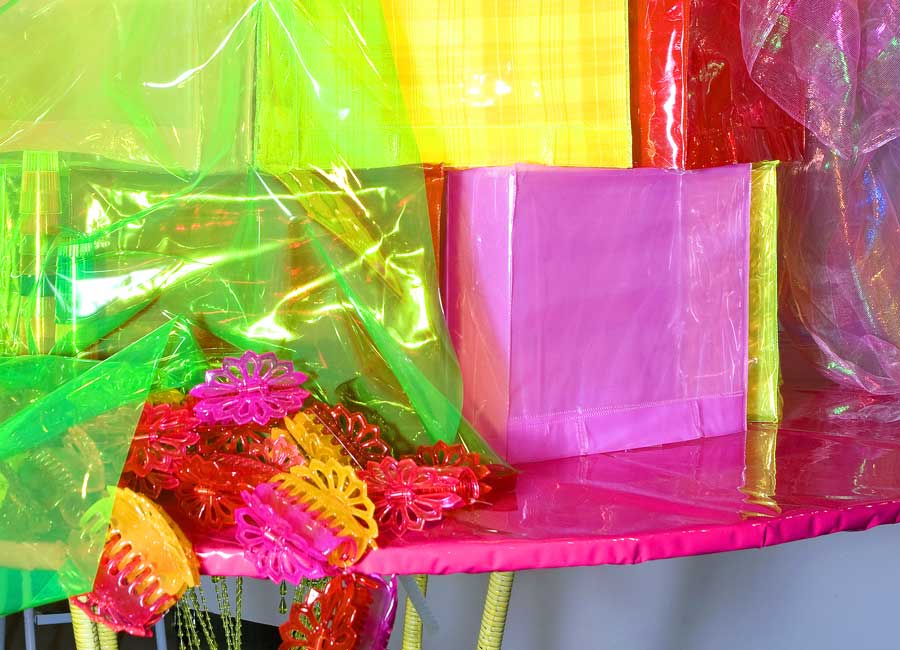
Veritas
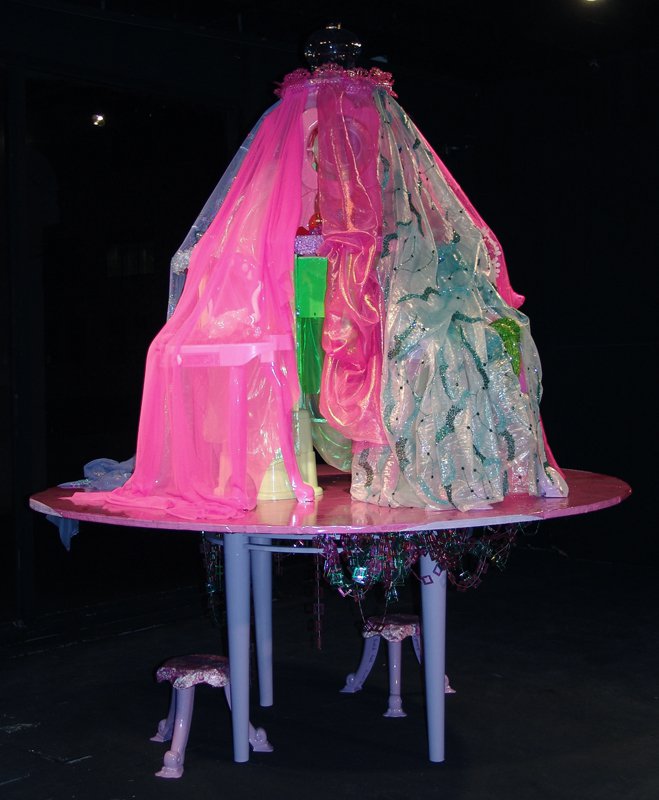
Vanitas
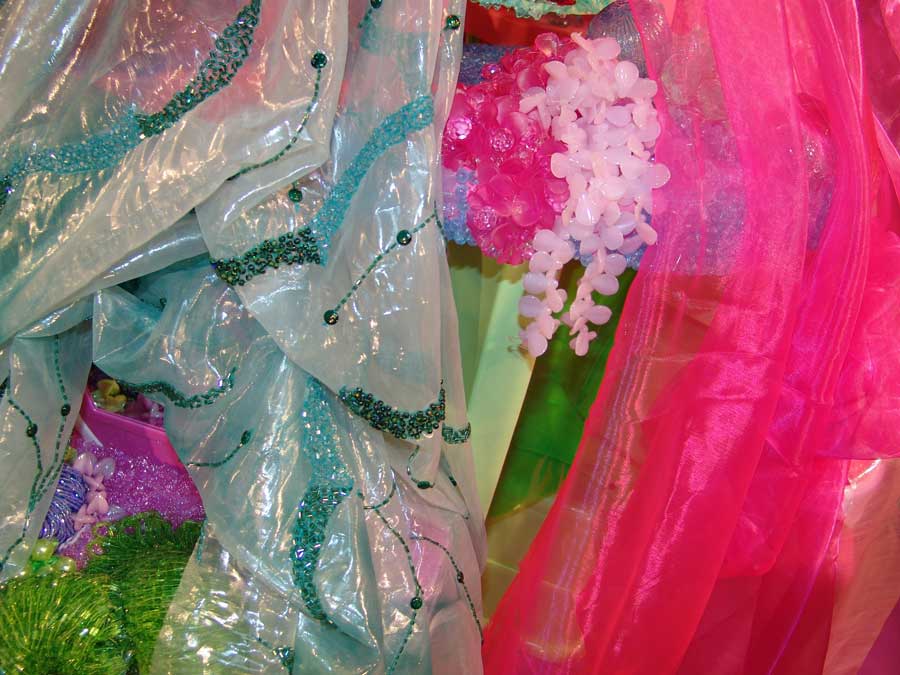
Vanitas (Detail)
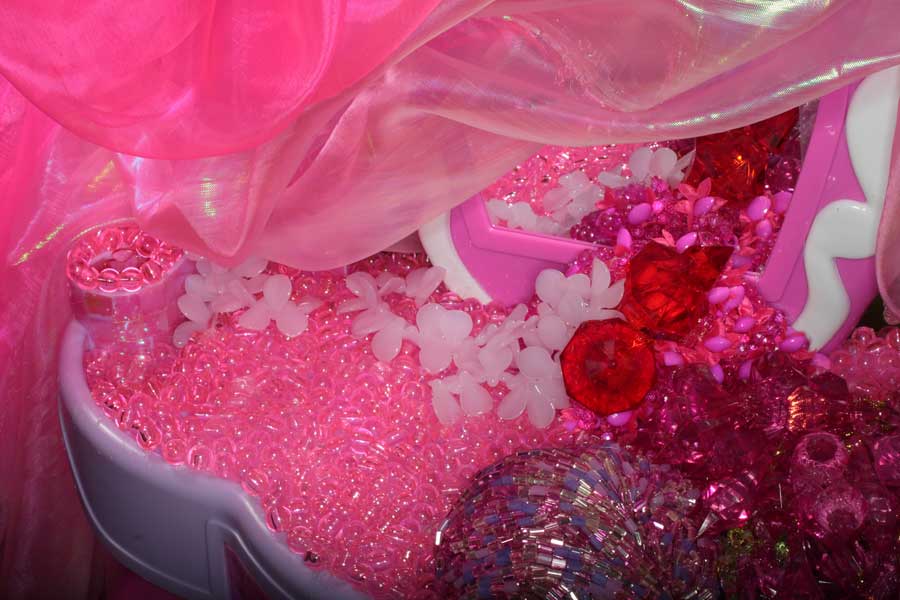
Vanitas (Detail)

Vanitas (Detail)
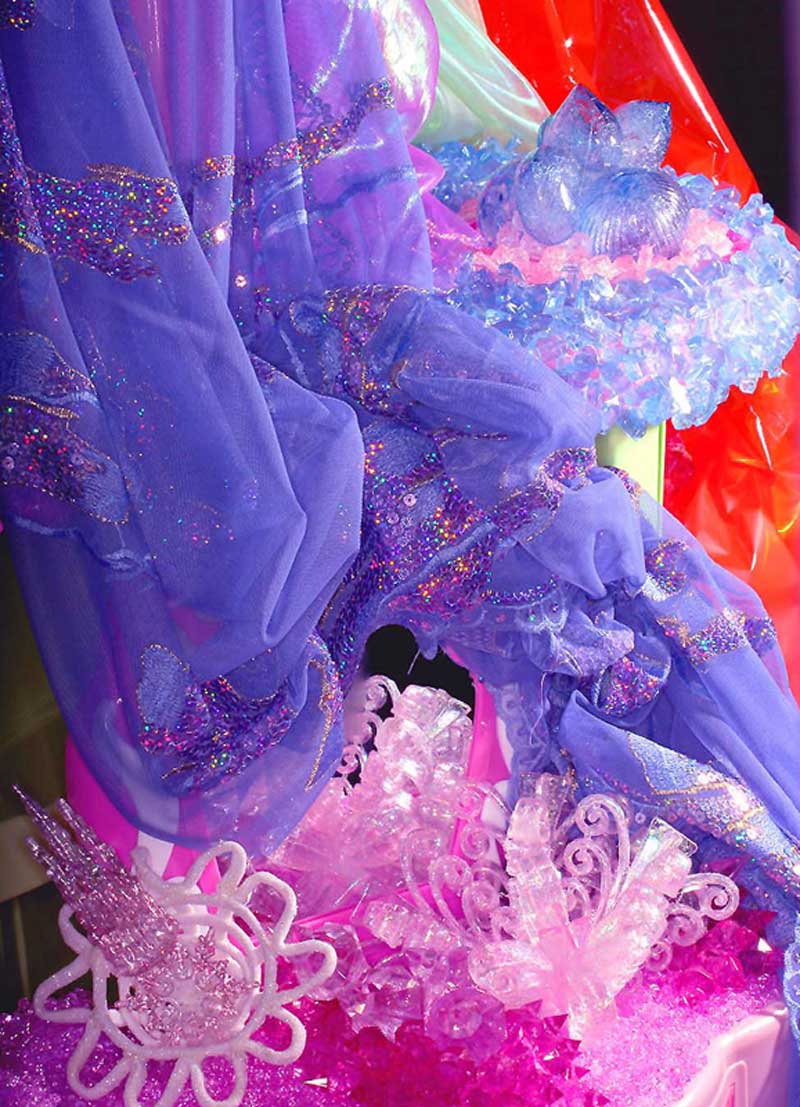
Vanitas (Detail)
"In polytheistic psychology's circularity of topoi there seem to be no preferred positions, no sure statements about positive and negative and therefore no need to rule out some configurations and topoi as pathological;. ...hence there can be more tolerance for the non-growth, non-upward, and non-ordered components of the psyche."
--James Hillman
Blue Fire
The folly of subterranean emotional life, the sublimely ridiculous, mystical dreaming--more intrigued by the 'uncool,' I'm not interested in making shrewd or prosaic things. Complexities of muddled emotions, narcissism, self-sabotage, self-delusion, stupor and intoxication attract me. Dostoevsky's Fyodor Pavlovich abjectly refuses to reign in his perverse whims, propensity to provoke. (Brothers Karamazov). Self-declared buffoon, he will not be denied the titillation of pulling the rug out from under any sanctified rite of decorum. Mortifying all present, he can't resist lampooning Catholic hypocrisy during a ceremonial family meeting with a top church elder. In Notes from the Underground, our needy narrator hounds a disdaining socialite to procure an invitation to a party. The day arriving, the narrator further demeans himself by turning up two hours early with desperation on his sleeve. Fitzgerald's The Beautiful and Damned Anthony Patch adopts irony and vacillates between self-effacement and aggrandizement all in the first paragraph.
I aim to traverse the murky depths of the subconscious, eluding the blandness of the conventional art world and vacuity of newest skateboard chic. It was 'Lunatic' Parsifal who asked the obvious question.
In River Town, Peter Hessler muses:
"I dislike Hamlet's hesitation. As a man he should do what he wants to do resolutely." (student's journal, Fuling China)
You couldn't have said something like that at Oxford. You couldn't simply say I don't like Hamlet because I think he's a lousy person. Everything had to be more clever than that; you had to recognize Hamlet as a character in a text, and then you had to dismantle it accordingly, layer by layer, not just the play itself but everything that had ever been written about it. You had to consider what all the other critics had said, and the accumulated weight of their knowledge and nonsense sat heavily on the play. You had to think about how the play tied in with current events and trends. This process had some value, of course, but for many readers it seemed to have reached the point where there wasn't even a split-second break before the sophistication started. As a student, that was all I had wanted -a brief moment when a simple and true thought flashed across my mind: 'I don't like this character. This is a good story.' This was what I was looking for as a student—some sign that literature was still enjoyable, that people read for pleasure and that this was important in and of itself. Apart from the politics In Fuling there was no question that the students enjoyed what they read Sometimes when they were working on an assignment, and I was looking out at the Wu River, I'd smile and think to myself: We're all refugees here. They've escaped from their classes on building Chinese socialism, and I've escaped from deconstructionism."
In buying hand-crafted Chinese furniture, baskets hand-woven on the islands of Cebu, Philippines, and silk hand-beaded in India to fold glibly into contemporary sculpture, I brandish American, suburban hubris. Craft/folk art is always an underpinning. Can I buy heart? In the global Capitalist paradigm, the 'fool' is the indigent craft laborer, forging exquisite colored glass lanterns in Morocco for quarters. Comically blanketing an old wooden Chinese footstool in plastic plaid hair clips epitomizes the foolishness of America. (Plaid invokes our imperialistic lineage, England and its vanquished.)
The fool is I. I am like Bartelby. I refuse to edit and calculate my actions (artwork) according to what is acceptable social code. I prefer not to manufacture cold, sanitized, cerebral, sparse, snide, or hackneyed rectangles to sell to lemmings, collectors of the insipid familiar. I make eclectic, overdressed, queer entities. What a fool am I to pour obscene amounts of labor into un-beige-enough-for-the-living-room-wall 'eccentricity.' A fool can't resist sap, sentimentality. Ever indulging in the one-step-too-far foppish, I can't resist adding wings to sculptures. A shameless dog, I have no dignity. Ultimately, like Coetzee in Disgrace, I rest my case on the intrinsic right to desire.
"The pleasure of the text is not necessarily of a triumphant, heroic, muscular type. No need to throw out one's chest. My pleasure can very well take the form of a drift. Drifting occurs whenever, by dint of seeming driven about by language's illusion, deductions, and intimidations like a cork on the waves, I remain motionless, pivoting on the intractable bliss that binds me to the text (to the world). Drifting occurs whenever social language, the sociolect, fails me... Thus another name for drifting would be: the Intractable—or perhaps even: Stupidity."
--Roland Barthes
the Pleasure of the Text
© 2006 Gae Savannah
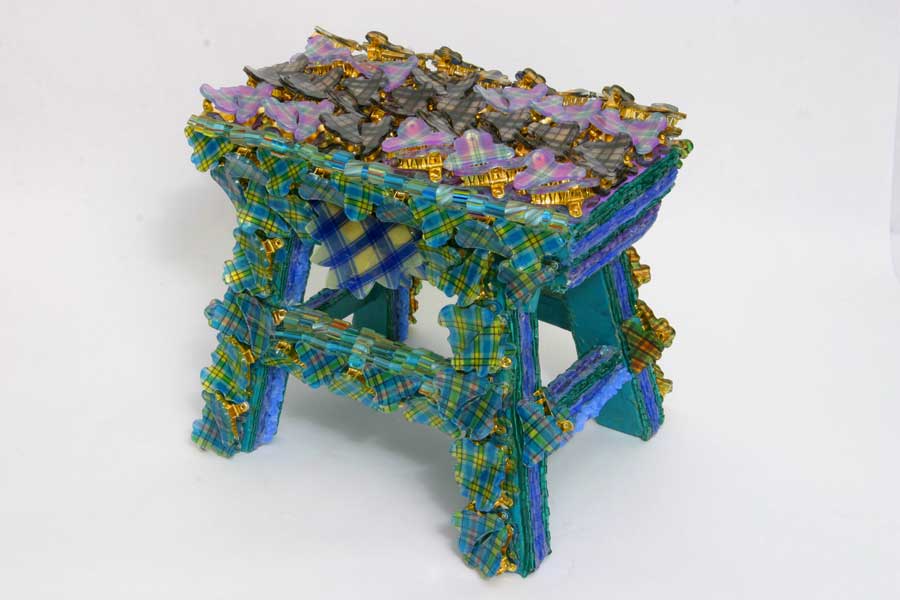
Kisu

Tiffy & Jaffy
"The very power and scope of Orientalism produced a kind of second-order knowledge with a life of its own, ...in effect,
Asia has become the West's "collective daydream of the Orient." The Orient then seems to be a theatrical stage affixed
to Europe [the West.]"
--Edward Said
Orientalism
Edward Said writes of the "domestication of the exotic." The attempt to reduce whole countries to over-embellished tchotchkes reflects an eye-candy, shopping-hypnotic mentality. Patisserie Chinoise (Chinese Bakery) evolved after visiting Shanghai in 2002 and realizing that I was standing in the future. I bought the hair accessories, silk brocade, etc. for the pieces there and in Beijing. So China fabricates plastic-everything, inexhaustible varieties of 'toys' to lull Americans into cheaper and more stylish convenience. Next, China, now itself buying the pretty items, wallops us economically, and becomes the new America. Ironically, Capitalism comes down to: the one with the most plastic wins. (Yes, there is a Walmart in Beijing.) Moreover, with previously quaint Shanghai now looking identical to any towering megalopolis in the world, we have irrevocable homogenizing globalization, loss of the charm and soul of folk culture.* So a French Patisserie can be Chinese --it's all mixed up, East and West. Particularities are being sucked into the tornado of the dollar/yuen consumer generic.
In Soul Mountain, in quite a more ambivalent mood than in the poetry of Sung dynasty painters who were transfixed by the same mountains of rural China, wryly sardonic author Gao Xingjian admits a sordid secret; he can't love anyone. As China manufactures us all further and further into dependent oblivion, (returning the favor of the opium Westerners generously provided in the 1800's,) all Gao can do now is continue his rambling, casting about the hinterlands for an emotional dimension (in folk songs) which is missing in contemporary action.
Alas, for nearly a century, East has been chasing West's advertising-hyped, slick possession-love. Yet few trendy Asian wannabes have noticed the emptiness of this candy-coated black hole. Conversely, I feel, the West should be looking Eastward to temples, Taoism, and gentleness. With a glut of yang in the developed world, we lack adequate yin; the extremes of urban verticality need compensating horizontal planes. Stretching in a wide horizontal arc across one's psyche, the archetypal outward sweeping curve of the pagoda roof manifests a resonant genzai. (Japanese for "present-ness.") This shape sustains a notion of infinitude and situates awareness in the timeless.
So, in the end Asia fetishist, these refulgent refuges, petite pavilions of dream, are but exotic, play-acting pastiche. Nonetheless, perhaps in some kind of a trance, you can still slip through the Maya surface, into a mountain-teahouse-like liminal interlude.**
* Harboring the labor-of-love aspect of craft, small, bungled foul-ups in pieces, (mismatched edges, pins, lumpy fabric, etc. ) reflect a repudiation of manufacturing's flawless execution, in favor of hand-wrought, failed craftsmanship.
** In Hindu culture, Maya is the intoxicating physical world of appearances, the veil of illusion, under which the true spiritual realm resides.
© 2002-04 Gae Savannah
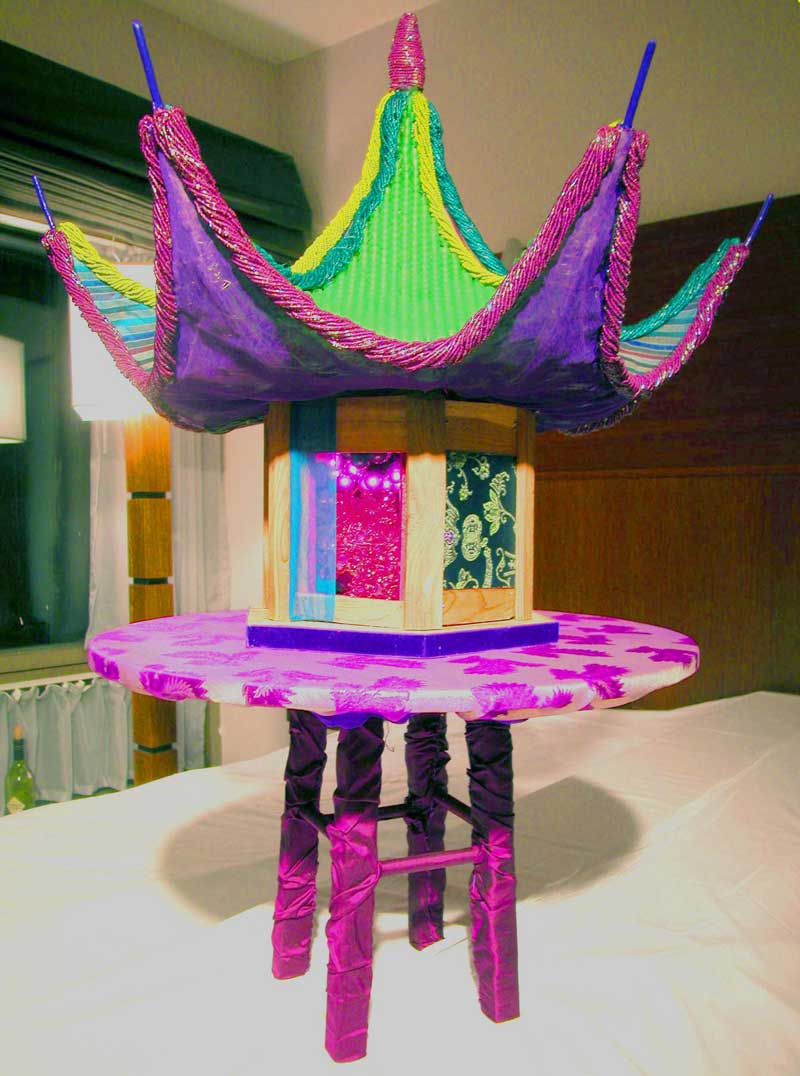
Kasja

Shia Shiung
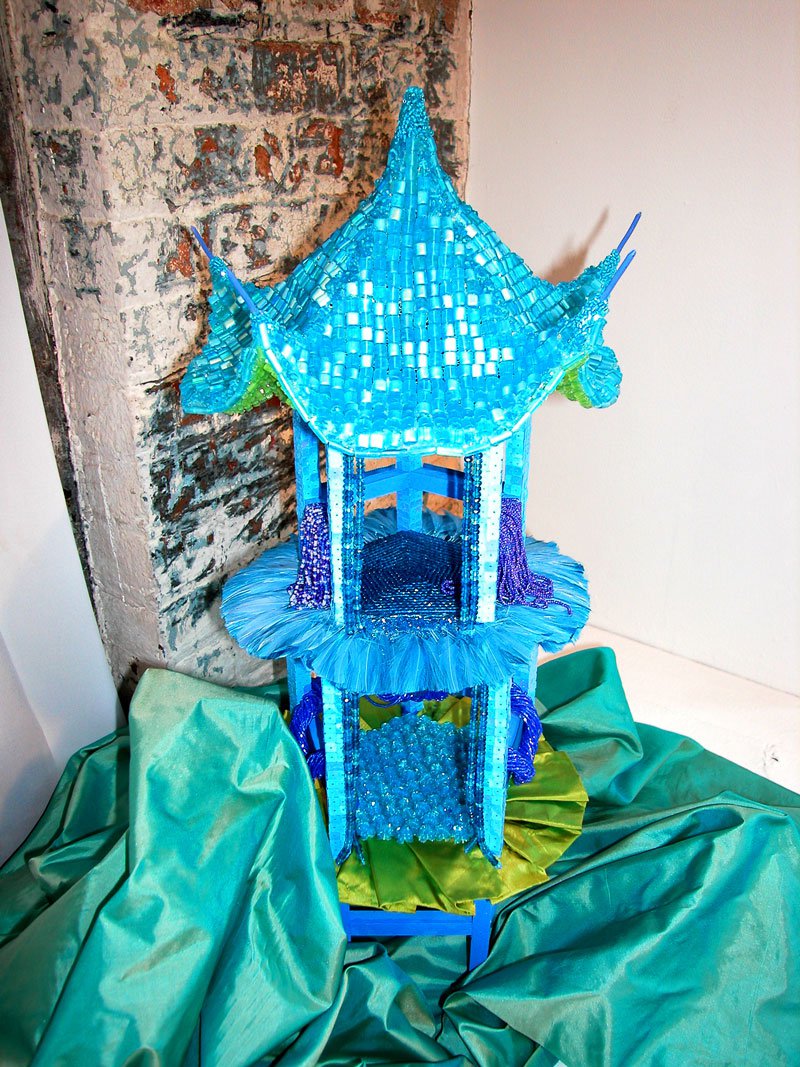
Shia Shiung (Detail)
Fatuous footstools femininity as confection, cream puff, cupcake, tartlette...
Kim Novak, (the Amorous Adventures of Moll Flanders;) Lisa Kudrow, (Romi and Michele's High School Reunion;) Caroline, dress-up duchess, (Anita Brookner's novel, Providence;) Hyacynth (British TV's Keeping Up Appearances;) the narrator's (mis)calculating mom of purple hat debacle, (Flannery O'Connor's Everything That Rises Must Converge;) and...
Footstools and Vanity Benches explores both intrinsic and fabricated femininity. Invoking "low art," (read: "girl art') --crafts, interior design, and fashion, I use fabric, hair accessories, beads, and Christmas and floral fare to debunk the value system of Fine Art where frivolity is still the poor cousin to austerity. Although undervalued, frivolity is not vacuous, but teeming with insight about our interior emotional life. Like itsy-bitsy, supra-beribboned doggies on Madison Avenue Manhattan, the benches are prim, preened, and poofed coquettes or wannabe princesses. The patterns --powder blue, French boudoir toile, striped Indian Shantung silk, and chartreuse Chinese silk brocade --make drawing room or bedroom culture palpable. All in all, spruced up, poised to please, both fetching and ungainly characters stir up the visceral desires of the beholder.
Like those of materials, twists of language can divulge the paradoxical nature of what we deem "profound" or "superficial." In Thomas Mann's Death in Venice, it is frills that spawn lucid, cogent prose. "Glamour" originated in a Scottish corruption of the term "grammar." "Narmada," the holiest river in India, means "whore." "Cosmetics" and "cosmos" notwithstanding, harkened from the same French root, and on Keats' Grecian Urn, prettified is even "petrified."
"Maja," one piece's title, is derived from Maya, the Hindu goddess of material appearances. Maya personifies the central philosophical concept of Hinduism --that the physical world, although intoxicating in its multiplicity and diversion, is actually a veil of illusion. To Hindus, beneath what our senses tell us, there is a sustaining spiritual foundation. But in America, foundation is manufactured by Cover Girl. To attain the revered "flawless finish," our goddess is not Maya but Maja, powder and perfume with a hackneyed Spanish flamenco dancer logo sold in cheap variety stores in Queens.
Fabric can be defined as both an internal framework, as in the fabric of society and as an external covering. Like veils which both conceal or accentuate, appearances not only lie but also tell the truth.
© 2002 Gae Savannah
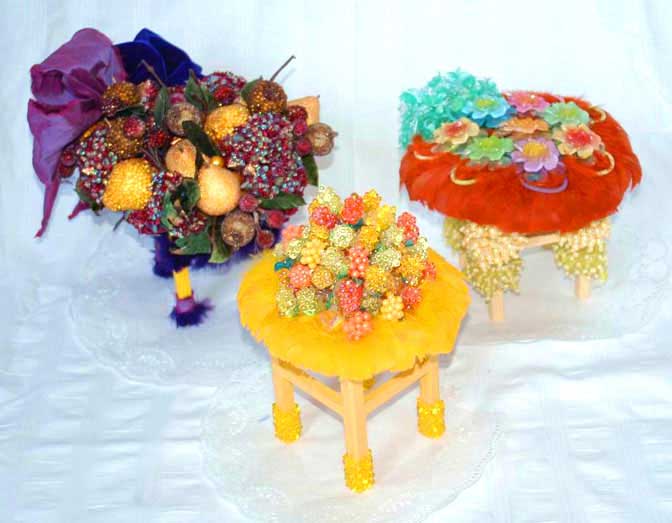
Patisserie 3 of 21
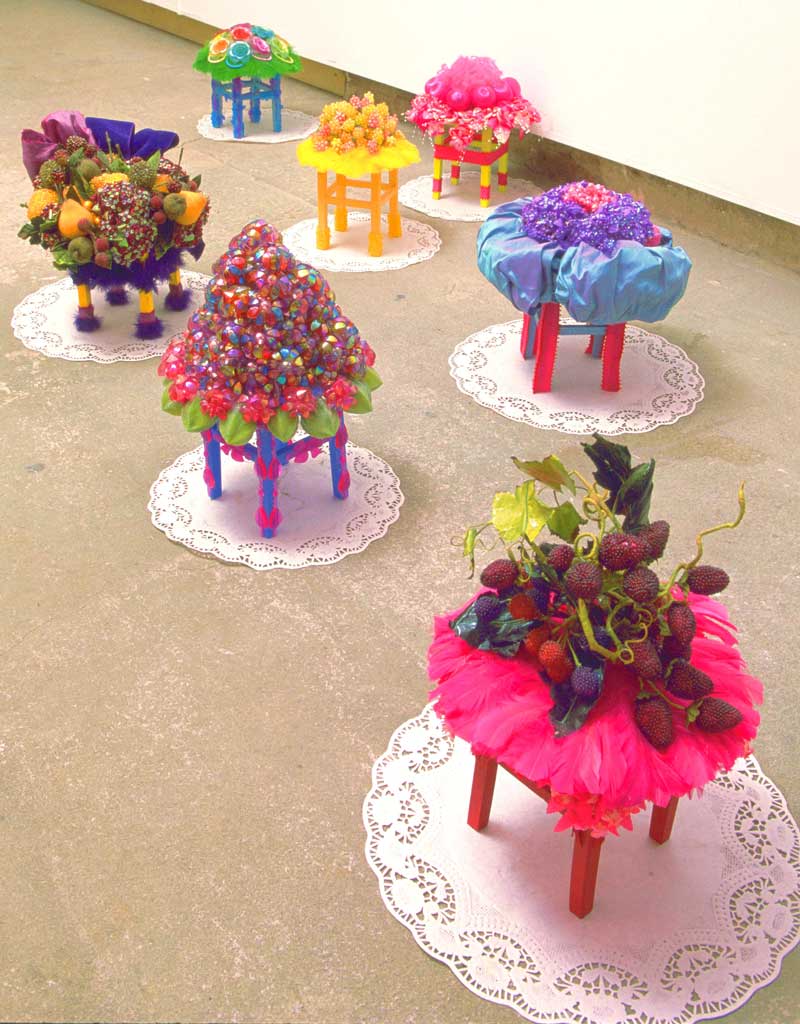
Patisserie 7 of 21
^